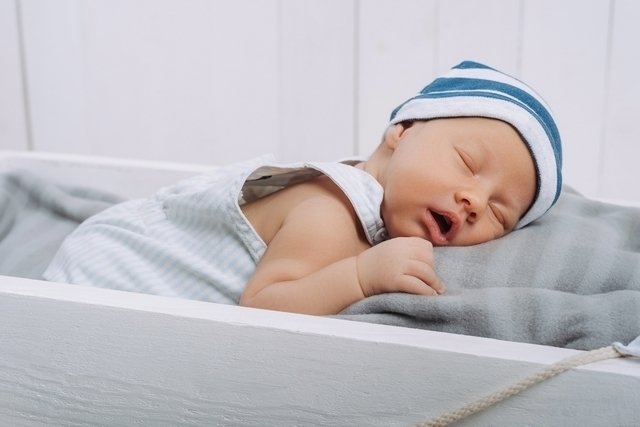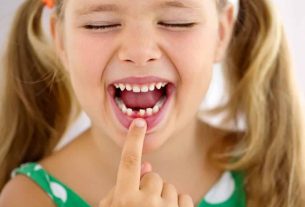Sleep apnea in babies occurs when the child stops breathing momentarily while sleeping, leading to a decrease in the amount of oxygen in the blood and brain. This situation most often occurs in the first month of life and occurs mainly in premature babies or those with low birth weight.
Sleep apnea can be identified through some signs and symptoms, such as noises when breathing, breathing through the mouth and fingertips and/or purplish lips.
It is important that the pediatrician is consulted so that tests can be carried out to help confirm the apnea and identify the cause so that the most appropriate treatment can be initiated to improve the baby’s quality of life.

Main symptoms
The main symptoms of sleep apnea in babies are:
- Noises when breathing during sleep, as if they were snoring;
- Stopping breathing during sleep;
- Mouth breathing;
- Decrease in heart rate during sleep;
- Purple fingertips and baby’s lips;
- The baby may become very soft and lethargic.
Generally, small stops in breathing do not cause any harm to the baby’s health and can be considered normal. However, if the child does not breathe for more than 20 seconds and/or if this is frequent, the child should be taken to the pediatrician.
How the diagnosis is made
The diagnosis of sleep apnea in babies must be made by a pediatrician and, normally, it is necessary for the baby to stay in the hospital to be monitored and their sleep observed. In addition, blood tests may be recommended to rule out other changes, such as a blood count, to rule out anemia or infections, and serum bicarbonate measurement, to rule out metabolic acidosis.
Make an appointment with your nearest pediatrician to assess the possibility of sleep apnea in your baby:
Taking care of your health has never been easier!
Possible causes
The cause of sleep apnea in babies cannot always be identified. However, some situations that increase the possibility of sleep apnea are:
- Asma;
- Bronchiolitis;
- Pneumonia;
- Tonsils and adenoids larger than normal;
- Malformations in the bones of the skull or face;
- Neuromuscular changes.
Apnea can also be caused by gastroesophageal reflux, seizures, cardiac arrhythmias or a failure at the brain level, which is when the brain stops sending the stimulus to the body to breathe and this last cause cannot always be identified but the pediatrician comes to this diagnosis when the baby presents symptoms and no changes are found in the tests performed.
What to do when your baby stops breathing
If there is a suspicion that the baby is not breathing, you should check whether there is a rising and falling movement of the chest, whether there is a sound of breathing and whether it is possible to feel the exit of air by placing your index finger under the baby’s nostrils. baby. You should also check whether the baby’s color is normal and whether the heart is beating.
If the baby is really not breathing, you should call an ambulance immediately by calling 192, and you should try to wake the baby by holding it in your arms and calling for it.
After sleep apnea, the baby must start breathing on its own only with these stimuli, because breathing usually stops quickly. However, if the baby takes a while to start breathing on his own, mouth-to-mouth resuscitation can be performed.
How to give your baby mouth-to-mouth resuscitation
To perform mouth-to-mouth resuscitation on the baby, the person helping the baby must place their mouth over the baby’s entire mouth and nose at the same time. Because the baby’s face is small, the open mouth must be able to cover both the baby’s nose and mouth. It is also not necessary to inhale deeply to offer a lot of air to the baby because his lungs are very small, so the air that is inside the mouth of the person who is going to help is enough.
Also find out how to give your baby a cardiac massage if his heart isn’t beating either.
How the treatment is carried out
Treatment for sleep apnea in babies may vary depending on the cause. In the case where apnea occurs due to enlargement of the tonsils or adenoids, surgery may be indicated to remove these structures, which favors breathing and improves the baby’s quality of life.
If the apnea is related to diseases of the respiratory system, such as asthma, bronchiolitis or pneumonia, for example, it is important to follow the doctor’s instructions, who may recommend the use of specific medications, helping to alleviate the symptoms and, consequently, the apnea.
In more serious cases, it may be necessary to use specific equipment, suitable for the baby, which aims to encourage breathing, as it creates pressure in the airways, so that they remain open and promotes the passage of air.
Possible complications
Sleep apnea in babies, when left untreated, can have some consequences for the child, such as brain damage, developmental delays and pulmonary hypertension, for example. Furthermore, a change in children’s growth may also occur due to a decrease in the production of growth hormone, as it is produced during sleep and, in this case, its production is reduced.

Sign up for our newsletter and stay up to date with exclusive news
that can transform your routine!
Warning: Undefined array key "title" in /home/storelat/public_html/wp-content/plugins/link-whisper-premium/templates/frontend/related-posts.php on line 12
Warning: Undefined array key "title_tag" in /home/storelat/public_html/wp-content/plugins/link-whisper-premium/templates/frontend/related-posts.php on line 13



